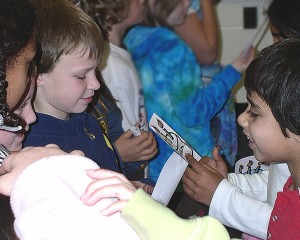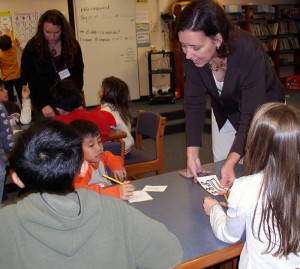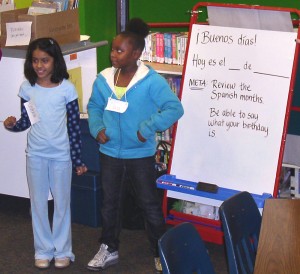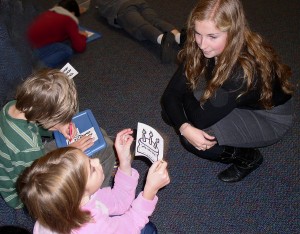By Casey Hans
AAPSNews Service
Ann Arbor third-graders are saying “hola!” this fall to new lessons that teach them the basics of Spanish language and encourage them to speak it.

The Ann Arbor Languages Partnership between The Ann Arbor Public Schools and the Teacher Education Program at the University of Michigan has been planned over several years, but was implemented just this fall in all 21 elementary school media centers.
Around the district, it’s known as World Language.
Forty-one U-M students, generally working in teams of two, serve as apprentice teachers under the supervision of Ann Arbor elementary media specialists. Third-graders visit the media centers twice each week for half-hour classes.

“I think it’s going really well. The kids are really excited,” said Shelagh Fehrenbach, a U-M student teaching Spanish at King Elementary School. “They’re using (Spanish) it in other places (around the school) too.”
Fehrenbach and Marly Van Huis are co-teaching the class and both also work at King as student teachers this year. This double effort “is nice because we really get to know the students,” said Van Huis.
The program is expected to expand to include fourth- and fifth-graders in 2010-11, dovetailing into language offerings at the middle school. If the partnership proceeds as planned, officials are hopeful that more languages can be added in the future.
King Principal Kevin Karr said parents touring his school often ask about foreign language offerings for elementary students. “I think it hits the need of what parents want,” he said, adding that the partnership sends a positive message that Ann Arbor is offering programs that are desirable to the community.
“I think it’s been great so far,” Karr added. “Clearly the teaching is going well – they’ve got a good style. The kids are very engaged. It’s not just sitting and learning. The kids are interacting.”
An Ann Arbor Public Schools online community survey in March 2008 asked parents’ opinion of a World Language program in the district. Eighty-five percent said they would strongly favor it and the top languages preferred among those responding were Spanish, Chinese and French. Some 12 percent responding said their children did not attend the district and 468 of those said they would be attracted to the district if elementary school language classes were offered.
Ann O’Keefe, media specialist at King, said the World Language program has added another dimension to the school. “It offers us a world of shared culture,” she said. “This is one more aspect of it. It gives us a lot to celebrate.”

At Haisley Elementary, media specialist Kristen Stoops said students in her center love it. “I see their enthusiasm when they’re here. They’re engaged and interested,” she said.
Tana Ebaugh is a University of Michigan research associate and lead trainer for the program. She visits classes and observes apprentice teaching styles. On this day, she is at Ann Arbor Open @ Mack, where a blended class of third- and fourth-graders are learning to discuss their birthdays. No English is spoken during the half-hour class – only Spanish. “It’s very different for them,” Ebaugh said, noting that students are learning by listening and participating.
Kit Flynn, media specialist at Ann Arbor Open said her school has a number of Spanish-speaking students for which the program serves another purpose. “It gives them a coaching role,” she said. “It gives them a time to shine.”
Since Ann Arbor Open encompasses grades kindergarten through eight and has blended-grade classes, she said the use of Spanish is spreading quickly around the building. “Lots of teachers have embraced it, putting Spanish signage in their classroom,” she said. “I hear a lot of mixed English and Spanish (being spoken) around the building.”
Throughout the district, elementary media specialists are adding more Spanish-language books to their collections. Flynn estimates she now has upwards of 200 such books at Ann Arbor Open.
Lee Ann Dickinson-Kelley, Ann Arbor schools administrator for elementary education, said she is pleased with how program has taken off around the district in just a few weeks. “It’s exceeding our expectations right now,” she said.
Dickinson-Kelley said although each school is unique and each instructional team can approach the material differently, there are standard lesson plans. The Schools “are all incredibly different,” she said. “We wanted to have the unique environment, but have a common high standard of learning.”

Maria Coolican, project director for the partnership on behalf of U-M’s School of Education, said the university is committed to the project. “We are in full recruitment mode (for apprentice teachers) for next year,” she added. There will be 90 openings for people to instruct as the program moves into grades three through five.
Dickinson-Kelley called the World Language program a high priority and said it is a “bulls-eye to the district’s long-term Strategic Plan.” She said an elementary language option is key as the district moves toward stricter state high school graduation requirements that include language.
“We want all of our kids to be multilingual,” she added. “It’s an essential tool – a skill they will need to have.”
Casey Hans edits this e-newsletter for The Ann Arbor Public Schools. E-mail her or call 734-994-2090 X51228.



